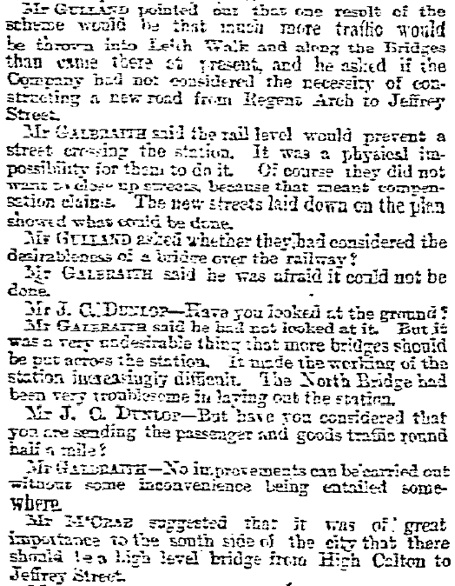
History of the Route: Objections
Waverley Redevelopment: Objections to Closing Cranston Street
By the late 1800s, Waverley Station was overcrowded, poorly laid out, and in need of redevelopment. The North British Railway (NBR) Company (who owned Waverley) drew up plans for redevelopment which included acquiring and clearing the land from Cranston Street to New Street (as seen in the map on the previous page). As part of this, the north section of Cranston Street between Market Street and New Street was to be closed up. There were also other contentious aspects of the NBR proposal, such as taking land from Princes’ Street Gardens, the acquisition of Waverley Market, and the location of the goods station. However, amongst these various issues, the closure of Cranston Street was the first objection brought up when the NBR brought their plans before the Town Council.
‘The Edinburgh Town Council and the Railway Schemes’

Mr Galbraith said the rail level would prevent a street crossing the station. It was a physical impossibility for them to do it. Of course they did not want to close up streets, because that ment compensation claims. The new streets laid down on the plan showed what could be done.
Mr Gulland asked whether they had considered the desirableness of a bridge over the railway?
Mr Galbraith said he was afraid it could not be done.
Mr J. C. Dunlop—Have you looked at the ground?
Mr Galbraith said he had not looked at it. But it was a very undesirable thing that more bridges should be put across the station. It made the working of the station increasingly difficult. The North Bridge had been very troublesome in laying out the station.
Mr J. C. Dunlop—But have you considered that you are sending the passenger and goods traffic round half a mile?
Mr Galbraith—No improvements can be carried out without some inconvenience being entailed somewhere.
Mr McCrae suggested that it was of great importance to the south side of the city that there should be a high level bridge from High Calton to Jeffrey Street.
• • •

Mr Galbraith said the directors would very anxious to meet the wishes of the Corporation in the matter. This was, however, one of the places where, perhaps, a subway would be more convenient, as it did not interfere with the rails in any way, which a bridge unquestionably did.
• • •
‘St Cutherbert’s Ward and the Schemes’

Extracts from the Scotsman, 1 October 1890
